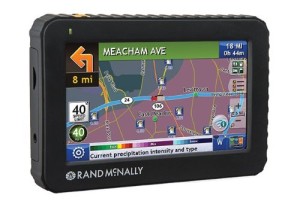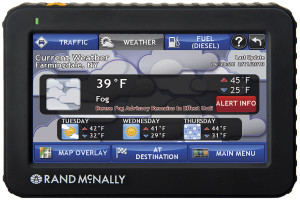The Rand McNally Intelliroute TND 520 Truck GPS is as close to a trucker’s best friend as his or her trusty dog. Providing much more then just which highway to use, when to turn and how much farther to go, GPSs for commercial truck drivers have came a long time in a short time, and no doubt many new features are coming down the road.
The invention of GPS was a great thing, especially for the trucking industry. However, the early GPS systems were geared for 4-wheelers and as such while useful for truck drivers, to a point, they could also get a driver in a lot of trouble real quick. Every truck driver has to be aware of road restrictions such as height, weight or width limitations on their planned route. The first GPSs allowed for assistance with routing and route planning but after that, it was still not much more then a tool in the driver’s tool box. However, with the Rand McNally Intelliroute series of Truck GPS units, the GPS moves from being a tool in the driver’s bag of tricks but the Swiss Army Knife of all in one tools that long haul or flex route drivers need.
Highlighted features of the Rand McNally Intelliroute TND 520 Truck GPS
Weather – Show current conditions and forecast. Optionally choose from 10 different map overlays, including precipitation and wind speed.Weather and road conditions are the biggest single threat to your completing your assigned deliveries. Knowing what is going on in a timely manner permits you to consider alternate routes to avoid problem areas.
Fuel prices – View fuel prices on the map, or search by price, fuel type, or brand. When burning up 100 gallons of fuel a day, getting your maximum value for your money can add substantially to your annual net income.
Fuel log – Track fuel purchases by date and by state; calculate current and average fuel economy. When it comes time to file your IFTA reports – every 3 months – you will need much of this information. The Rand McNally Intelliroute TND 520 Truck GPS can assist you in maintaining your records accurately so you pay what you are suppose to pay but not over pay by paying fuel taxes in the wrong jurisdictions. Knowing your fuel economy can also teach you to be a better truck driver. Many drivers just drive until they need fuel and dump more in without paying attention to their driving habits, including bad habit that may be costing the money.
Team driving support – the TND250 allows you to keep timers and mileage separately for two team members. Every tool that allows the driver to maintain maximum utilization of the their log book increases your profitability. With the Rand McNally Intelliroute TND 520 Truck GPS, you have one more check and balance to assist you in not making a costly mistake. One wrong mistake on your log book could result in you being red-tagged out of service and fined $100s.
Highlighted features of the Rand McNally Intelliroute TND 520 Truck GPS has a large easy to read 5″ screen and comes with a windshield suction cup and charger. Once you take this co-pilot for a test drive, you will never drive solo again.

